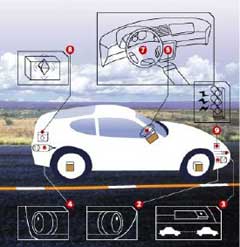Cambridge is about to test a self-steering bus that uses a camera mounted at the top of the windscreen to follow lines painted on the road. As it does not deviate more than a few millimetres from its course, the bus lane can be be 1.5m (5ft) narrower than those used by driver-steered buses.
The bus will also guide itself to within 4cm of the kerb at bus stops, allowing level boarding for disabled passengers and people with pushchairs.
The camera can look up to 100m ahead, recognising the parallel lines of dashes and sending a signal to a box on the steering mechanism. The steering wheel vibrates as soon as the system detects the lines, informing the driver that it is safe to remove his hands. However, the driver continues to control acceleration and braking and can override the device at any time to steer the bus around obstacles. An alarm sounds if the optical guidance system cannot find the lines.
The system was developed by Siemens and has already been introduced in Rouen in France and will soon be used on buses in Bologna in Italy. Both cities, like Cambridge, have networks of ancient streets that cannot comfortably accommodate conventional buses.
Via The Times.

Parodia Electronica has recently developed a satellite-guided self-steering system for cars that, in tests, is accurate to within 50 centimeters. Parodia’s system uses differential GPS location data to generate servo commands from a car’s navigation system that activate an electro-hydraulic steering mechanism.
Via Jalopnik and Transport Trends.
